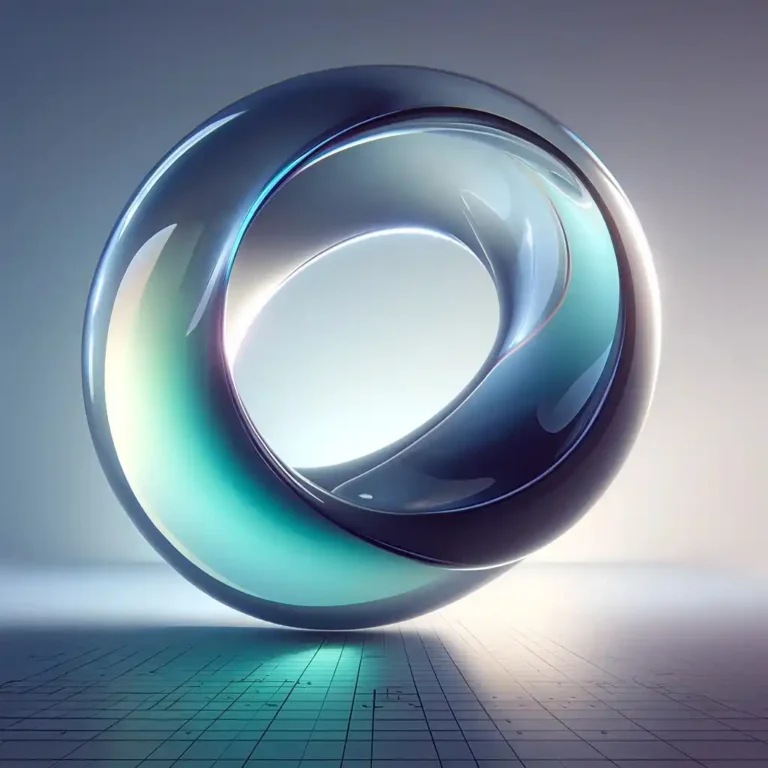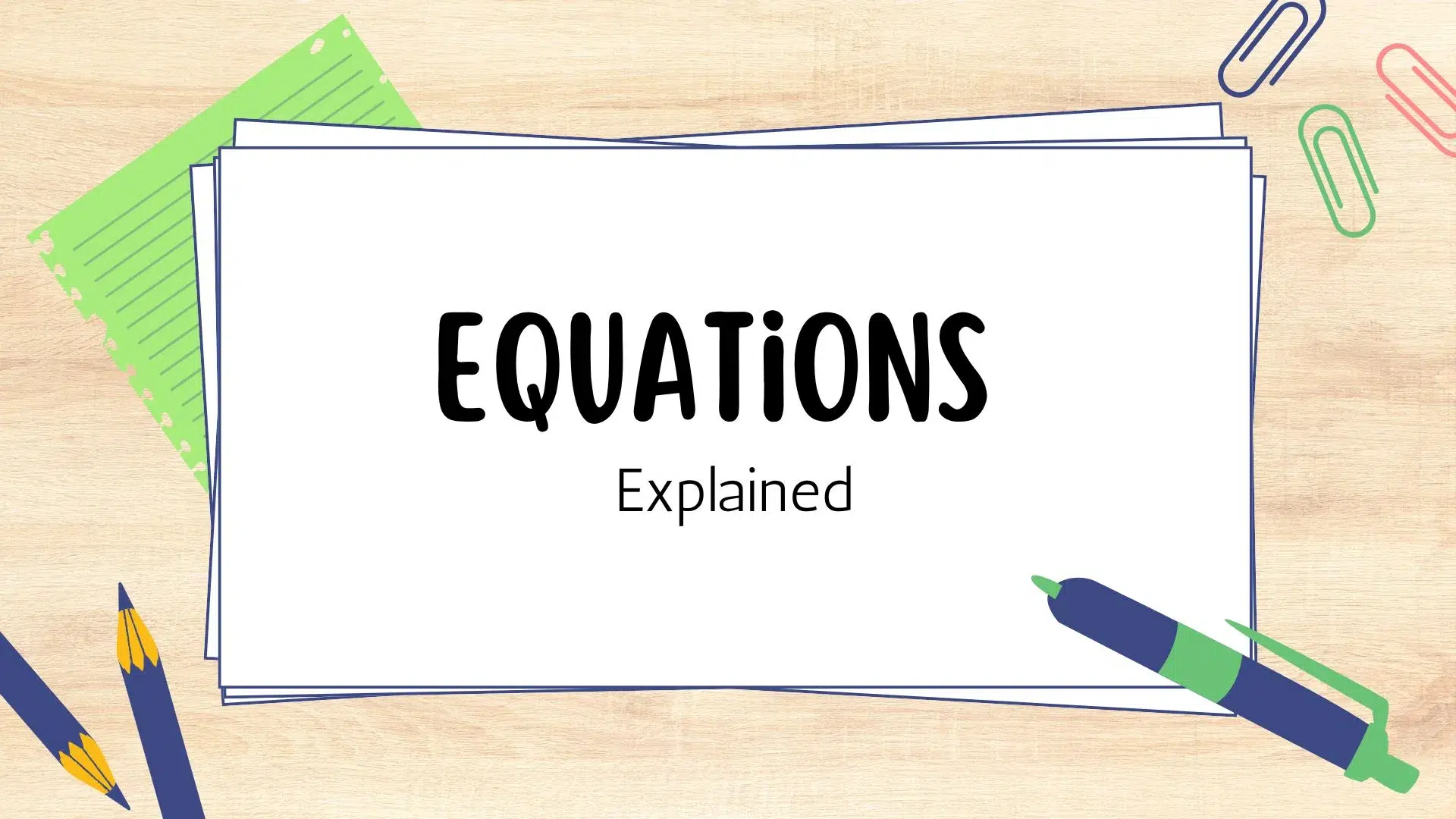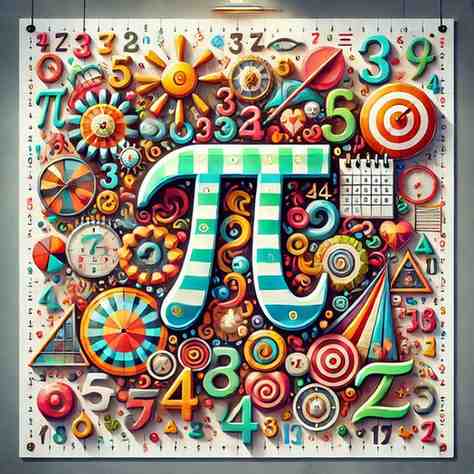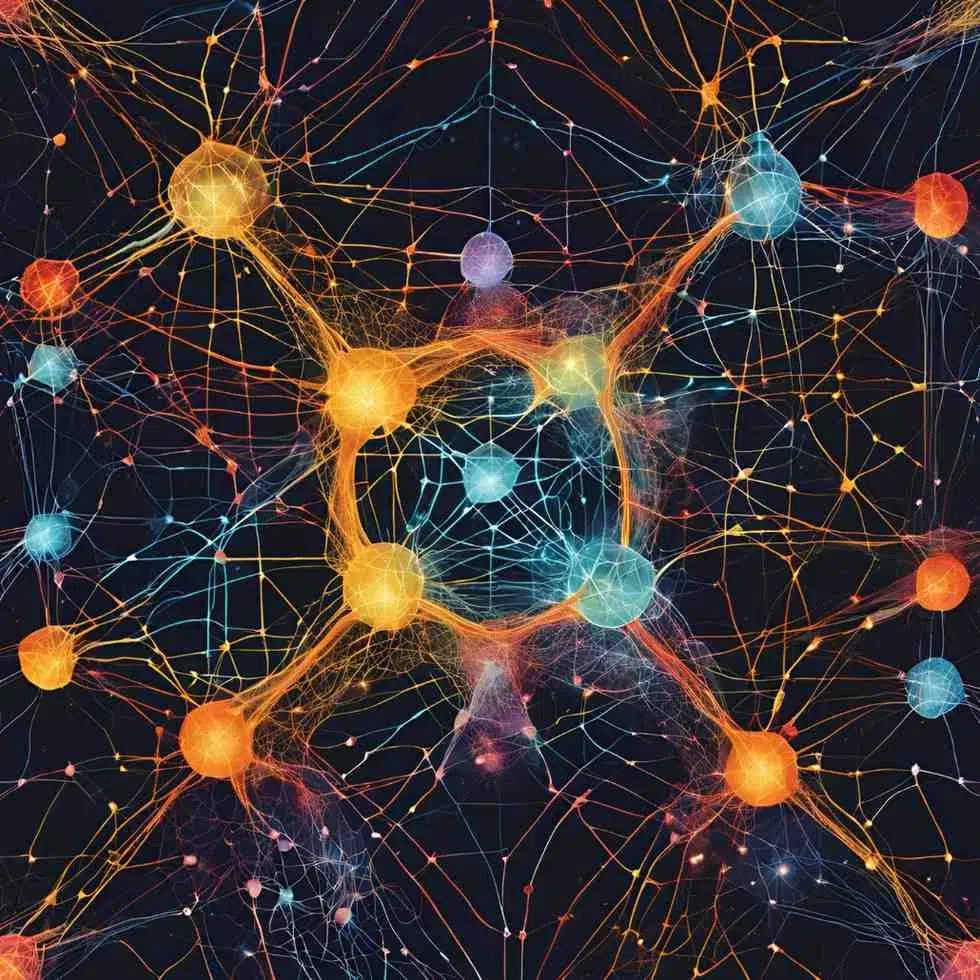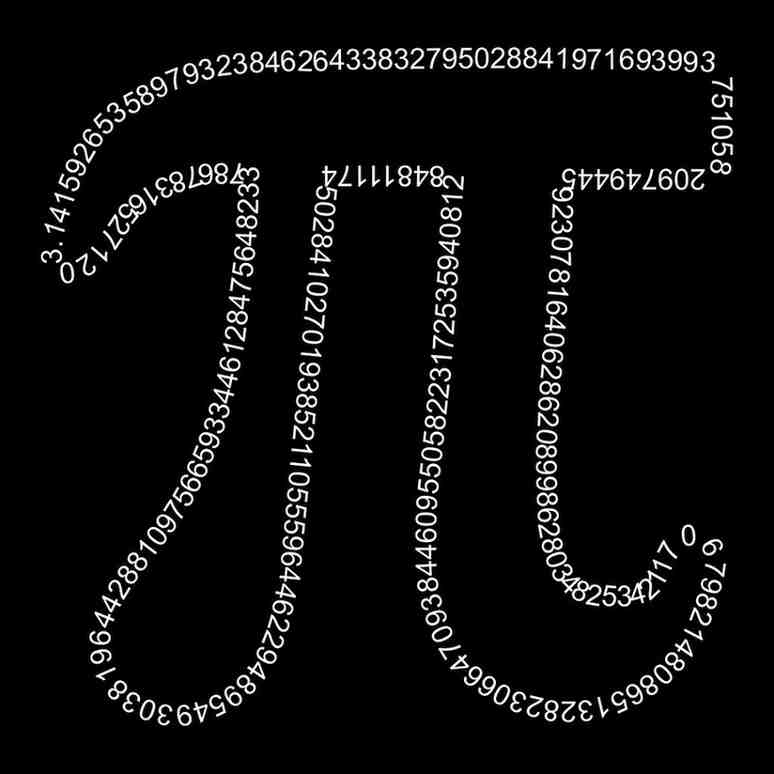Topology, often referred to as “rubber-sheet geometry,” is a fascinating branch of mathematics that explores the properties of shapes and spaces that remain unchanged under continuous deformations. Unlike geometry, which focuses on precise measurements and angles, topology delves into the essence of shapes, emphasizing their fundamental structure rather than their exact dimensions. This field has profound implications in mathematics, science, and beyond, offering insights into everything from the behavior of the universe to the design of modern networks.
Understanding Topology: The Basics
Topology is the mathematical study of shapes, spaces, and their properties under continuous transformations. Unlike geometry, which focuses on precise measurements like angles, lengths, and areas, topology emphasizes the fundamental structure of objects. It examines how spaces can be stretched, twisted, or deformed without breaking or gluing, focusing on what stays consistent through these transformations.
Key Concepts in Topology
- Open and Closed Sets
Topology begins with the idea of open and closed sets, which help define the structure of spaces.- Open Set: A set of points is open if, for every point in the set, there’s a small “neighborhood” of points around it that also belong to the set. For example, in a number line, the interval (0,1) is open because it doesn’t include the endpoints 0 and 1.Closed Set: A set is closed if it contains all its boundary points. The interval [0,1]which includes 0 and 1, is closed.
- Homeomorphism
Homeomorphism is a critical idea in topology. It describes a continuous deformation between two shapes that doesn’t involve tearing or gluing.- For example, a circle and an ellipse are homeomorphic because one can be stretched into the other without cutting or joining.
- A coffee mug and a doughnut are also homeomorphic because they both have one hole, even though they look different.
- Connectedness
Connectedness describes whether a space is all in one piece or can be split into separate parts.- A space is connected if it cannot be divided into two disjoint, non-overlapping subsets. For instance, a circle is connected because there’s no way to split it without cutting.
- A space is disconnected if it consists of separate parts, like two distant points or two separate loops.
- Compactness
Compactness is a property that generalizes the idea of being finite. A space is compact if it is “small” in a topological sense, meaning every sequence of points within the space has a limit point also within the space.- For example, a closed interval [0,1] on the real number line is compact, but the open interval (0,1) is not because it doesn’t include its boundary points.
Intuition Behind Topology
To understand topology intuitively, imagine working with a piece of clay.
- You can stretch, twist, or mold the clay into different shapes, but as long as you don’t tear it or glue new pieces together, its topological properties remain the same.
- For instance, if you start with a ball of clay, you can reshape it into a cube, a sphere, or even a blob, and it remains topologically equivalent. However, if you poke a hole in it or attach a new piece, you change its topological nature.
This flexibility makes topology a powerful framework for studying the essence of shapes and spaces, regardless of their precise dimensions or measurements.
Topology in Action
Topology might seem abstract, but it has practical applications in various fields, from physics to computer science. Let’s explore some areas where topology plays a crucial role.
1. Physics and the Universe
Topology is instrumental in understanding the shape and structure of the universe. Concepts like wormholes, black holes, and the fabric of spacetime involve topological ideas. In quantum mechanics, topological properties of materials lead to phenomena like the quantum Hall effect, which has implications for advanced technologies.
2. Biology and Medicine
In biology, topology helps model the structure of DNA, which can twist and loop in complex ways. Understanding these shapes is crucial for genetic research. Similarly, in medicine, topological methods are used in brain imaging and the study of neural networks.
3. Computer Science and Data Analysis
Topology has found its way into computer science, particularly in fields like data analysis and machine learning. Topological data analysis (TDA) uses the shape of data to identify patterns and structures that traditional methods might miss. This approach is especially useful in high-dimensional data sets.
4. Engineering and Design
Topology optimization is a method used in engineering to design structures and materials that are lightweight yet strong. By understanding the fundamental shape of objects, engineers can create innovative designs for everything from bridges to aircraft.
Fascinating Topological Phenomena
Topology is full of intriguing and mind-bending concepts that challenge our intuition about shapes and spaces. These phenomena often serve as gateways to understanding the deeper principles of topology and its applications. Let’s explore some of the most fascinating topological phenomena.
1. The Möbius Strip
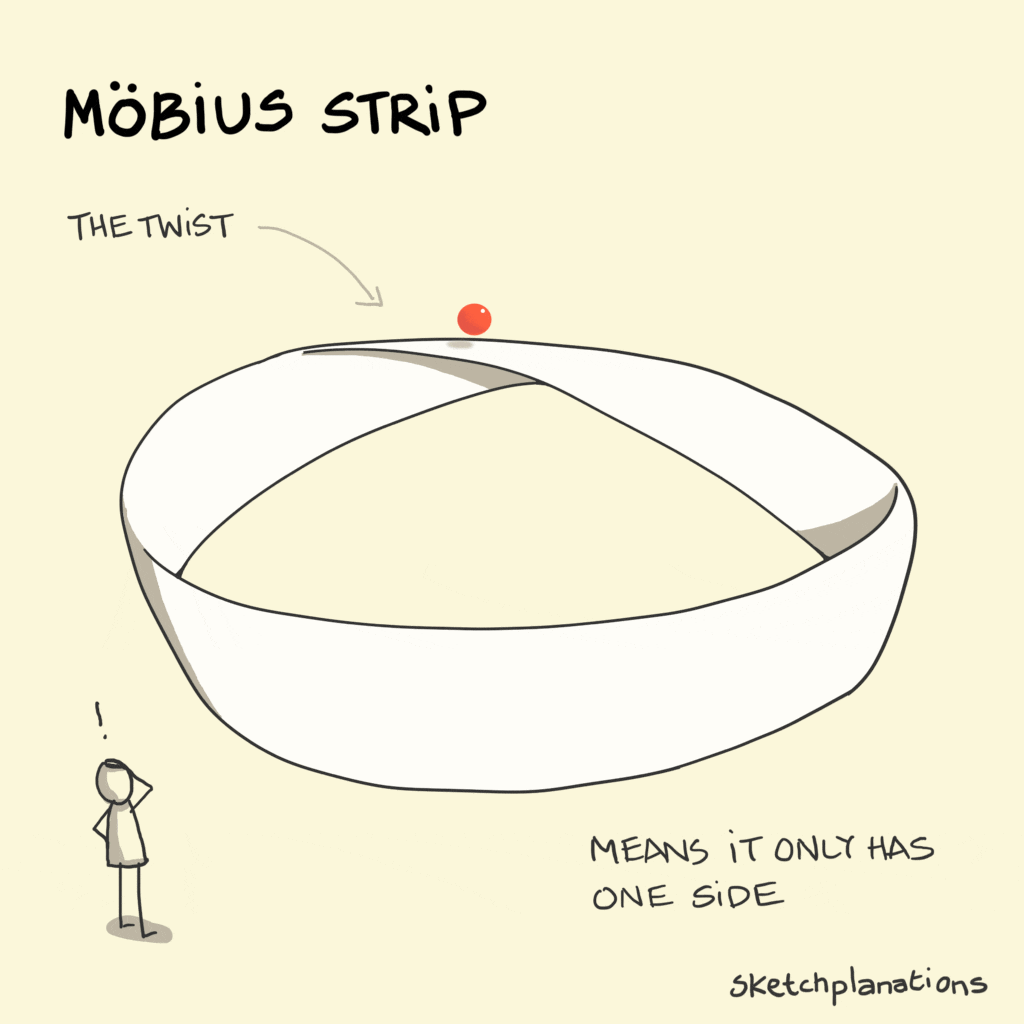
The Möbius strip is one of the most famous objects in topology. It is a surface with only one side and one edge, defying the conventional notion of “sides.”
How to Create a Möbius Strip:
- Take a strip of paper, twist it 180 degrees, and join the ends.
- The result is a surface where, if you start drawing a line on one side, you’ll eventually end up on the “other” side without lifting your pen.
Why It’s Fascinating:
- The Möbius strip is non-orientable, meaning it has no distinct “inside” or “outside.”
- It has applications in engineering (e.g., conveyor belts) and art, symbolizing infinity and continuity.
2. The Klein Bottle
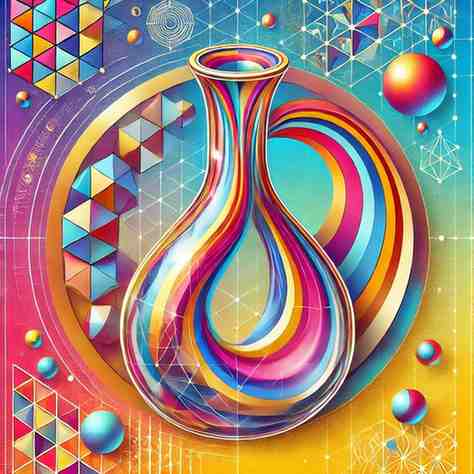
The Klein bottle is a step beyond the Möbius strip, representing a non-orientable surface with no boundaries.
What Makes It Special:
- A true Klein bottle cannot exist in three-dimensional space without self-intersecting. It can only be fully realized in four dimensions.
- Imagine taking a cylinder, giving it a twist (like a Möbius strip), and then connecting the two ends in such a way that the “inside” and “outside” merge seamlessly.
Applications and Symbolism:
- Klein bottles are used to explore higher-dimensional spaces and non-orientable surfaces.
- They are often used as visual tools in mathematics to explain complex concepts.
3. Euler’s Formula for Polyhedra
Leonhard Euler discovered a remarkable relationship that applies to all convex polyhedra: F + V – E = 2
Where:
- V is the number of vertices,
- E is the number of edges,
- F is the number of faces.
Why It’s Fascinating:
- This formula is a cornerstone of topology, revealing a deep connection between the structure of polyhedra and their topological properties.
- It holds true for a vast range of shapes, from simple cubes to complex geodesic domes.
Applications:
- Euler’s formula helps in computer graphics, architecture, and understanding the topology of networks.
4. The Seven Bridges of Königsberg
This famous problem, solved by Leonhard Euler in 1736, involves a city with seven bridges connecting different landmasses. The challenge was to find a path that crosses each bridge exactly once.
Euler’s Insight:
- He proved that such a path is impossible, laying the groundwork for graph theory.
- He abstracted the problem into a network of nodes (landmasses) and edges (bridges), introducing the concept of topological graphs.
Why It’s Fascinating:
- The problem demonstrates how topology can simplify and solve real-world problems by focusing on the connections between objects rather than their exact shapes.
- Graph theory, which emerged from this problem, is now used in computer science, transportation planning, and network analysis.
5. The Torus and Its Unique Properties
A torus, commonly visualized as a doughnut shape, is a fascinating topological object with unique properties.
Topological Features:
- Unlike a sphere, a torus has a hole in the middle, making it topologically distinct.
- It can be represented mathematically as a product of two circles.
Applications:
- The torus appears in physics (e.g., in magnetic fields and plasma containment in fusion reactors).
- It is also used in computer graphics to create seamless textures and loops.
6. The Poincaré Conjecture
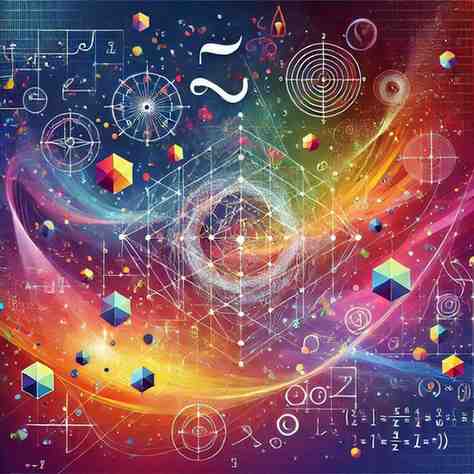
The Poincaré Conjecture, one of the most famous problems in topology, was proposed by Henri Poincaré in 1904 and solved by Grigori Perelman in 2003.
The Conjecture:
- It states that any three-dimensional shape that is “simply connected” (i.e., without holes) and has no boundary is topologically equivalent to a sphere.
Why It’s Important:
- The conjecture was a central question in understanding three-dimensional spaces.
- Perelman’s proof earned him the prestigious Fields Medal, though he famously declined it.
Applications:
- The solution has implications for understanding the shape of the universe and the behavior of three-dimensional spaces.
Why These Phenomena Matter
These topological phenomena are not just mathematical curiosities—they have real-world applications and provide profound insights into the nature of shapes, spaces, and connections. From the Möbius strip’s simplicity to the Poincaré Conjecture’s complexity, these concepts demonstrate the power and beauty of topology as a “secret language of shapes.”
By studying these phenomena, mathematicians and scientists can better understand the underlying structure of the universe, solve practical problems, and push the boundaries of human knowledge.
The Evolution of Topology
Topology has a rich history, evolving from ancient geometry to its modern form.
- Early Beginnings: The roots of topology can be traced back to geometry and the study of shapes. The ancient Greeks explored geometric properties, laying the groundwork for future developments.
- Euler and Graph Theory: In the 18th century, Euler’s work on the Königsberg bridges problem marked a shift towards studying shapes and spaces in a more abstract way.
- The Birth of Topology: In the 19th century, mathematicians like Johann Benedict Listing and Henri Poincaré formalized the study of topology, introducing key concepts and methods.
- Modern Developments: Today, topology is a vibrant field with numerous subfields, including algebraic topology, differential topology, and geometric topology. These areas explore different aspects of shapes and spaces, often intersecting with other branches of mathematics.
Why Topology Matters
Topology matters because it provides a unique lens through which we can understand shapes, spaces, and their fundamental properties, regardless of size, form, or precise measurements. This branch of mathematics is not just an abstract pursuit—it has practical applications that impact diverse fields, from science to technology.
- Understanding the Universe
Topology helps physicists and cosmologists explore the shape and structure of the universe. Concepts like spacetime topology and black hole dynamics rely on topological principles to describe phenomena that go beyond traditional geometry. - Applications in Data Science
In the era of big data, topology is used to uncover hidden patterns and relationships. Topological data analysis (TDA) helps scientists visualize complex datasets, revealing structures that would otherwise be invisible in raw data. - Innovation in Engineering
Topology optimization is a revolutionary approach in engineering. By applying topological principles, engineers design lightweight yet robust structures for applications like aerospace, automotive, and architecture. - Advancements in Biology
Topology models complex biological systems, such as DNA folding and neural networks. It provides insights into how these systems function and interact, aiding in breakthroughs in genetics and neuroscience. - Everyday Applications
Topology underpins technologies like GPS, computer graphics, and robotics. The seamless functioning of these systems often relies on topological algorithms to navigate, render, or map spaces effectively.
By focusing on the intrinsic properties of spaces, topology bridges the abstract and the practical. Its principles not only deepen our understanding of the natural world but also drive innovation in solving real-world problems. In essence, topology matters because it reveals the unchanging truths that underlie both the universe and human ingenuity.
A Universal Language
Topology transcends traditional boundaries, serving as a universal language for describing shapes and spaces. Its principles apply across disciplines, making it a cornerstone of modern science and mathematics.
Conclusion
Topology, the secret language of shapes, offers a unique perspective on the world around us. By studying the fundamental properties of shapes and spaces, topology uncovers patterns and connections that might otherwise go unnoticed. From its theoretical foundations to its practical applications, topology continues to shape our understanding of mathematics, science, and the universe.
Whether you’re a mathematician, scientist, or simply curious about the nature of shapes, topology invites you to explore a world where the impossible becomes possible, and the familiar takes on new meaning.
Topology FAQ
Here’s a list of frequently asked questions about topology, designed to help beginners understand this fascinating field of mathematics.
1. What is topology?
Topology is the study of properties of shapes and spaces that remain unchanged under continuous deformations, such as stretching, twisting, or bending, without tearing or gluing. It focuses on the fundamental structure of objects rather than their precise measurements.
2. How is topology different from geometry?
While geometry deals with exact shapes, sizes, and angles, topology focuses on the qualitative properties of shapes that remain unchanged under deformation. For example, a square and a circle are distinct in geometry but equivalent in topology because they can be continuously transformed into each other.
3. What are some real-world applications of topology?
Applications in various fields, including:
- Physics: Understanding spacetime, black holes, and quantum phenomena.
- Biology: Modeling DNA and neural networks.
- Computer Science: Data analysis, machine learning, and network design.
- Engineering: Topology optimization for lightweight and efficient structures.
4. What is a homeomorphism?
A homeomorphism is a continuous, one-to-one transformation between two topological spaces that has a continuous inverse. It shows that two spaces are topologically equivalent, meaning one can be deformed into the other without tearing or gluing. For example, a coffee mug and a doughnut are homeomorphic because both have one hole and can be reshaped into each other. Homeomorphisms preserve properties like connectedness and the number of holes but ignore geometric specifics like size or angles. They are fundamental in topology, helping classify spaces based on their intrinsic structure rather than their precise physical form.
5. What is a Möbius strip?
A Möbius strip is a fascinating topological object with only one side and one edge. It is created by taking a strip of paper, giving it a half-twist, and joining the ends. Unlike ordinary surfaces, the Möbius strip is non-orientable, meaning it has no distinct “inside” or “outside.” If you start drawing a line on one side, you’ll eventually return to your starting point on the “other” side without lifting your pen. The Möbius strip has practical applications in engineering, like conveyor belts, and symbolizes infinity and continuity in art and mathematics. It’s a classic example of topology’s wonders.
6. What is the difference between open and closed sets in topology?
Open and Closed sets are fundamental concepts used to describe the properties of spaces. Here’s the difference:
Open Sets
- A set is open if every point in the set has a neighborhood entirely contained within the set.
- Intuitively, an open set does not include its boundary points.
- Example: The interval (0,1)(0, 1)(0,1) on the real number line is open because points near 0 and 1 are not included in the set.
Closed Sets
- A set is closed if it contains all its boundary points.
- Closed sets can include the limit points of sequences within the set.
- Example: The interval [0,1][0, 1][0,1] is closed because it includes the endpoints 0 and 1.
Key Points:
- A set can be both open and closed (e.g., the entire space or an empty set).
- Some sets are neither open nor closed.
- Open Set: A set where every point has a neighborhood entirely contained within the set. For example, the interval (0,1) is open.
7. What is the Poincaré Conjecture?
The Poincaré Conjecture is a famous problem in topology proposed by Henri Poincaré in 1904. It states: Every simply connected, closed three-dimensional manifold is topologically equivalent to a three-dimensional sphere. Simply connected means the space has no holes, and every loop can be continuously shrunk to a point. The conjecture was a cornerstone of geometric topology and remained unsolved for nearly a century. In 2003, Grigori Perelman provided a proof using Richard Hamilton’s Ricci flow technique, earning widespread acclaim. The conjecture’s resolution advanced our understanding of three-dimensional spaces and earned Perelman the Fields Medal, which he famously declined.
8. What is a torus?
A torus is a doughnut-shaped surface with one hole. It is topologically distinct from a sphere because of the presence of this hole. Tori are used in physics, computer graphics, and engineering.
9. What is connectedness in topology?
Connectedness refers to whether a space is all in one piece or can be split into separate parts.
- Connected Space: Cannot be divided into two disjoint subsets.
- Disconnected Space: Can be separated into distinct parts.
10. What is compactness?
Compactness is a property of a space that generalizes the idea of being finite. A compact space is one where every sequence of points has a limit point within the space. For example, the interval [0,1] is compact, but (0,1) is not.
11. What is a Klein bottle?
A Klein bottle is a non-orientable surface with no boundaries or edges. It can only exist in four dimensions without intersecting itself. In three dimensions, models of Klein bottles are often self-intersecting.
12. How does topology relate to graph theory?
Graph theory, a field closely related to topology, studies the connections between nodes (vertices) and edges in a network. Problems like the Seven Bridges of Königsberg laid the foundation for graph theory, which has applications in computer science, transportation, and social networks.
13. Why is topology called “rubber-sheet geometry”?
Topology is sometimes called “rubber-sheet geometry” because it studies properties of shapes that remain unchanged when stretched, twisted, or bent, much like a flexible rubber sheet.
14. Why is topology important?
Topology is important because it provides a framework for understanding the fundamental structure of shapes and spaces. Its concepts have applications in mathematics, science, engineering, and technology, influencing fields as diverse as cosmology and artificial intelligence.
